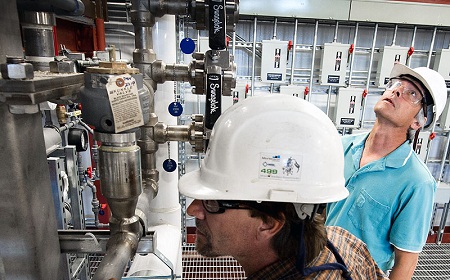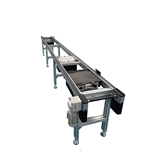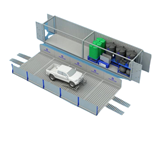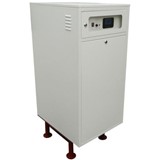In June, DOE announced an award of up to $13.4 million dollars to Virent and its partners to develop a process to cost effectively convert cellulosic biomass — in this case the non-edible parts of corn — into jet fuel.
"Projects such as these are helping us to diversify our energy portfolio and decrease our dependence on foreign oil," Energy Secretary Steven Chu said at the announcement.
"Together with our partners, the Department is working hard to expand the clean energy economy, creating jobs in America and providing sustainable replacements for the fuels and products now provided primarily by petroleum."
"This is all about making drop-in fuels or infrastructure-compatible fuels," NREL Manager for Bioprocess R&D Richard Elander said.
"These are fuels that are close, if not identical, to the same molecules that are in gasoline, diesel fuel, and jet fuel. They are compatible with our existing vehicles and infrastructure in terms of engines, fueling and pipelines."
It is important to note that the end result of the combined NREL-to-Virent lignocellulosic conversion process is not ethanol. While ethanol is a reasonable substitute for gasoline, is not a substitute for jet fuel due to ethanol's lower energy density and other properties required for jet fuel.
"Rather than fermenting corn stover into ethanol, in this scenario, the biomass is appropriately deconstructed and then catalytically converted into energy dense hydrocarbon molecules that are indistinguishable from petroleum based jet fuel," Virent Senior Director for Feedstock Development Andrew Held said.
Idaho National Laboratory will provide the corn stover for the experiments. NREL will then use acid or other chemicals to pre-treat and deconstruct the biomass, creating a new compound, or hydrolysate, containing sugars and other forms of soluble carbon.
"One of the interesting features of the Virent technology is, not only can they uses simple sugars, they can also use slightly longer chain sugars, plus they can also use some of the 'undesirable' products from when we over-treat the biomass," Elandar said.
Over-treating happens in the lingocellulosic conversion process because the biomass has to be broken down enough to get to the hard-to-reach sugars. The process is not perfect, so some of those sugars can be over-treated and become sugar degradation products.
According to Elander: "This particular process has the opportunity to use a wider range of sugars and other soluble carbon compounds that are generated in the deconstruction process than we've traditionally been able to, which is a good thing because it means potentially higher yields."
Virent will take the hydrolysates produced in NREL's Integrated Biorefinery Research Facility (IBRF) and use a proprietary catalytic conversion technology to make the final jet fuel.
"We remove the oxygen to make the deconstructed biomass more amenable to further processing, ultimately turning the hydrolysates into the same hydrocarbons that make up ordinary jet fuel," Held said.
While NREL has an important role in the agreement in deconstructing the quantities of biomass needed for the project, the lab has two other equally important tasks. First, NREL will perform techno-economic analysis of the project to make sure it is financially feasible in the long run, and second, NREL will study the fundamentals properties of catalysts used in the process.
"One of the challenges that has to be demonstrated by Virent is the lifetime of their catalyst," Elander said.
"The only way to prove that a catalyst will last a long time is to run it for a long time. In order to run it for a long time, they are going to need a large quantity of deconstructed biomass to put through. NREL's IBRF will come into play to generate several tons for this process. We can then gauge how the catalyst behaves."
NREL recently completed the second phase of a $33.5 million upgrade to the IBRF. The facility is unique in its ability to handle a wide range of biomass feedstocks and pretreatment processes. Three parallel pretreatment processing trains allow for the testing of conversion processes using differing technologies under a wide range of conditions.
The IBRF can handle high concentrations of solids in the pretreatment and enzymatic hydrolysis steps, a key factor in reducing costs. In addition, NREL has fuel testing capabilities and facilities and is a recognized leader in techno-economic and life cycle analyses.
"Virent has been very impressed with the technical capabilities of NREL as a result of our work with the National Advanced Biofuels Consortium," Held said.
"When we were planning a project to put to together for this DOE award, we thought NREL's team would be a very good fit in terms of supplying us feedstock materials needed for Virent's catalytic conversion technology."
NREL and DOE are looking for more partners like Virent to help speed the integration of drop-in fuels into America's existing infrastructure.
"I think the DOE is appropriately trying to encourage national labs and private parties to work together," Held said.
"This project embodies top-notch experience and capability at a national lab with a promising company that is moving forward with innovative technology."
The IBRF's new equipment and facilities, including 27,000 square feet of high bay space, can support unparallel research flexibility for industrial partners. Industry partners can bring in new technologies or processes into the IBRF to evaluate them in an integrated biorefinery setting.














-160x160-state_article-rel-cat.png)

-160x160-state_article-rel-cat.png)







-160x160-state_article-rel-cat.png)

